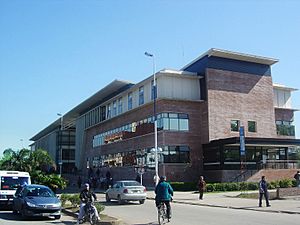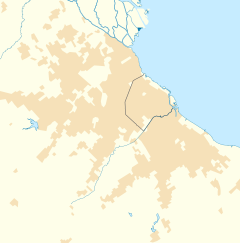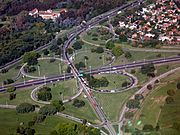Ezeiza, Buenos Aires facts for kids
Quick facts for kids
Ezeiza
|
|
|---|---|

City Hall
|
|
| Country | |
| Province | |
| Partido | Ezeiza |
| Founded | 17 July 1885 |
| Elevation | 12 m (39 ft) |
| Population
(2010 census)
|
|
| • Total | 160,219 |
| Demonym(s) | Ezeizenses |
| CPA Base |
B 1804
|
| Area code(s) | +54 11 |
Ezeiza is an important city in Argentina. It is the capital of the Ezeiza Partido, which is like a county. This city is part of the larger Greater Buenos Aires area.
In 2010, about 160,219 people lived in Ezeiza. It is one of the fastest-growing cities in Argentina. Ezeiza and the areas around it are known for their many private neighborhoods with gates. It is also home to the Ministro Pistarini International Airport and a large federal prison complex. People often see Ezeiza and its surroundings as wealthy areas.
Contents
History of Ezeiza
Early Beginnings and Founding
Long ago, the Querandí people lived on the land where Ezeiza is now. In 1588, explorers from Spain claimed the land. The first large farm, called an estancia (which is a big ranch), and a small church were built here in 1758. They were started by Juan Guillermo González y Aragón. One of his great-grandsons was Manuel Belgrano, a very important leader in Argentina's fight for independence.
Later, in 1767, a man named Gerónimo Ezeiza bought land nearby. By the late 1800s, his descendant, José María Ezeiza, owned the most land in the area. After he passed away, his son-in-law gave some land to the Buenos Aires Western Railway. A new town grew around this railway line. It was officially founded on July 17, 1885, and was named Ezeiza to honor José María Ezeiza.
Growth and Development
In the early 1900s, dairy farming was a very important activity in Ezeiza. The town was chosen as the place for Argentina's very first international airport. This airport opened in 1949. A new neighborhood called Barrio Uno was built right next to the airport that same year. It was made for the airport employees to live in.
To connect the new airport to the city of Buenos Aires, the Ricchieri Freeway was opened in 1952. In 1967, the National Atomic Energy Commission set up the Ezeiza Atomic Center. This center is important because it makes radioisotopes, which are used in medicine.
Ezeiza continued to grow steadily. Many people moved there to live, but worked in other cities. These places are sometimes called "bedroom communities". From the 1990s, many gated communities (private neighborhoods with controlled access) were built, especially near Canning, south of the city. The Bosques de Ezeiza (which means 'Ezeiza Woods') are also a popular place for tourists to visit.
Modern Institutions
Ezeiza has important modern facilities. The Dr. Alberto Eurnekian Hospital opened in 2008. In 2012, the Provincial University of Ezeiza started. This university was the first in Latin America to focus on aeronautics, which is the science of flight. There was also a plan to make it a national university.
Ezeiza used to be part of the Esteban Echeverría Partido. But in 1994, Ezeiza became its own county, the Ezeiza Partido. A new, modern city hall building was opened in 2007.
Climate
| Climate data for Ministro Pistarini International Airport, Ezeiza (1991–2020, extremes 1961–present) | |||||||||||||
|---|---|---|---|---|---|---|---|---|---|---|---|---|---|
| Month | Jan | Feb | Mar | Apr | May | Jun | Jul | Aug | Sep | Oct | Nov | Dec | Year |
| Record high °C (°F) | 42.0 (107.6) |
38.8 (101.8) |
39.1 (102.4) |
34.1 (93.4) |
30.2 (86.4) |
28.2 (82.8) |
31.5 (88.7) |
34.0 (93.2) |
34.3 (93.7) |
35.8 (96.4) |
38.6 (101.5) |
41.1 (106.0) |
42.0 (107.6) |
| Mean daily maximum °C (°F) | 30.3 (86.5) |
28.8 (83.8) |
26.8 (80.2) |
22.9 (73.2) |
19.0 (66.2) |
15.9 (60.6) |
15.0 (59.0) |
17.5 (63.5) |
19.3 (66.7) |
22.2 (72.0) |
25.8 (78.4) |
29.0 (84.2) |
22.7 (72.9) |
| Daily mean °C (°F) | 24.1 (75.4) |
23.0 (73.4) |
21.0 (69.8) |
17.1 (62.8) |
13.6 (56.5) |
10.8 (51.4) |
9.8 (49.6) |
11.8 (53.2) |
13.8 (56.8) |
16.8 (62.2) |
20.0 (68.0) |
22.7 (72.9) |
17.0 (62.6) |
| Mean daily minimum °C (°F) | 17.9 (64.2) |
17.1 (62.8) |
15.4 (59.7) |
11.8 (53.2) |
8.9 (48.0) |
6.1 (43.0) |
5.2 (41.4) |
6.6 (43.9) |
8.3 (46.9) |
11.2 (52.2) |
13.8 (56.8) |
16.2 (61.2) |
11.5 (52.7) |
| Record low °C (°F) | 6.3 (43.3) |
3.8 (38.8) |
1.9 (35.4) |
−0.4 (31.3) |
−5.0 (23.0) |
−7.8 (18.0) |
−5.8 (21.6) |
−4.8 (23.4) |
−4.2 (24.4) |
−1.4 (29.5) |
0.0 (32.0) |
3.0 (37.4) |
−7.8 (18.0) |
| Average precipitation mm (inches) | 99.8 (3.93) |
108.5 (4.27) |
100.1 (3.94) |
100.6 (3.96) |
70.3 (2.77) |
48.4 (1.91) |
56.9 (2.24) |
59.3 (2.33) |
65.4 (2.57) |
106.6 (4.20) |
99.5 (3.92) |
99.5 (3.92) |
1,014.9 (39.96) |
| Average precipitation days (≥ 0.1 mm) | 7.6 | 7.3 | 7.4 | 8.1 | 6.7 | 6.6 | 6.4 | 6.2 | 7.0 | 9.2 | 8.2 | 7.7 | 88.5 |
| Average snowy days | 0.0 | 0.0 | 0.0 | 0.0 | 0.1 | 0.0 | 0.1 | 0.0 | 0.0 | 0.0 | 0.0 | 0.0 | 0.1 |
| Average relative humidity (%) | 65.6 | 70.6 | 74.2 | 77.3 | 79.7 | 78.5 | 77.6 | 73.8 | 71.7 | 71.9 | 67.0 | 64.1 | 72.7 |
| Source: Servicio Meteorológico Nacional | |||||||||||||
Notable People from Ezeiza
- Félix Décima (born 1979), a professional footballer.
See also
 In Spanish: Ezeiza para niños
In Spanish: Ezeiza para niños



